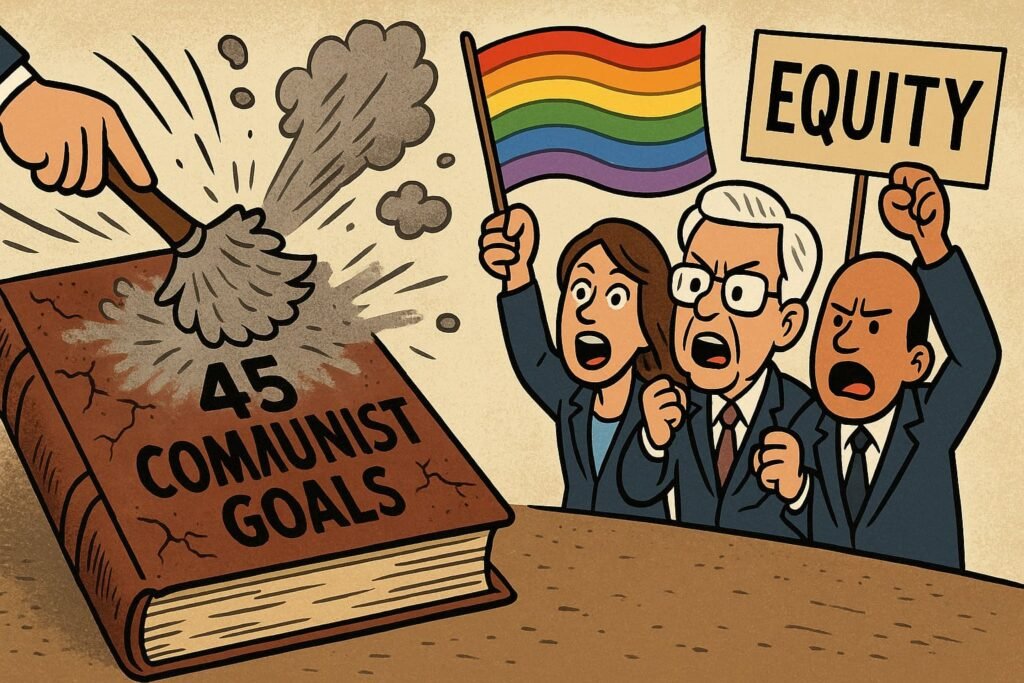The 45 Communist Goals Explained – From Cold War to Woke
In the 1960s, American politicians were haunted by communists under every bed. To prove it, they even entered a list of “45 Communist Goals” into the Congressional Record in 1963. It was supposed to be a secret playbook for subverting democracy. Most people laughed it off as paranoia.
Fast forward: half a century later, parts of the list look oddly familiar. Media control, education capture, rewriting history, weakening family and faith, redefining morality, even policing language — all things that pop up in today’s culture wars. Does this mean the communists won? Not quite. But it does show how the same ghost stories keep getting recycled. Yesterday it was communism. Today it’s “woke.”
Table of contents
Revisiting the 45 Communist Goals
The list comes from Cleon Skousen’s 1958 book The Naked Communist. In 1963, a congressman read it into the record, cementing it as Cold War folklore. The goals ranged from serious (infiltrate schools, control the press) to the absurd (promote obscenity, push “degeneracy” as normal).
For decades, the list lived in right-wing newsletters and conspiracy tracts. Now it’s making a comeback online, repurposed for the culture wars as “proof” that woke activists are carrying out a communist blueprint.
The Goals in Context
The Cold War was peak paranoia. America had just fought Korea, was staring down Cuba and Vietnam, and lived under the shadow of nuclear war. The idea that communists were plotting a cultural takeover fit the mood.
But the list was never an official document. It was a mash-up of fears, speculation, and political theatre. It wasn’t a KGB memo — it was a mirror reflecting America’s anxieties.
Parallels in Today’s Culture Wars
Still, some goals do sound uncomfortably close to today’s battles:
- Media & Education: Goal 17 (infiltrate schools) and Goal 20 (control the press). Today’s debates over CRT in classrooms or media bias echo that fear.
- Family & Morality: Goal 25 (break down cultural standards of morality). Think debates over gender identity, family values, and “traditional norms.”
- Free Speech: Goal 29 (discredit the Constitution). Swap in today’s speech codes, cancel culture, and “hate speech” laws.
- Division by Identity: Goal 26 (present homosexuality and promiscuity as normal). In 1963, shocking. In 2025, part of mainstream politics.
Are these communist victories? Or just society changing in ways the 1960s right feared?
Who Benefits from Recycling the List
Ironically, the real winners aren’t communists. They’re pundits, activists, and politicians who find the list a useful scarecrow.
- On the right, it’s proof that “woke = communism 2.0.”
- On the left, it’s dismissed as paranoia, reinforcing the idea that critics are conspiracy theorists.
- In reality, it’s a handy way to keep the public distracted while corporations, lobbyists, and governments carry on business as usual.
Why It Still Matters
The list is a reminder of how easily fear can be weaponised. In the 1960s, it kept Americans on edge about communism. Today, it keeps us fighting about “woke.” Different label, same function: divide and distract.
Conclusion
The 45 Communist Goals weren’t a prophecy. They were a Cold War panic list. But they’ve taken on a second life in the culture wars, used as proof that the enemy is everywhere. Communism then, wokeism now — the names change, but the strategy’s the same: scare people into obedience while real power operates elsewhere.
FAQ
What are the 45 Communist Goals?
A list from The Naked Communist (1958), entered into the U.S. Congressional Record in 1963, claiming to outline communist strategies for subverting America.
Are the 45 Goals real communist documents?
No. They were compiled by an American author, not from Soviet archives. They reflect Cold War fears, not official Soviet plans.
Why do people link the goals to woke politics today?
Because some points (media, education, morality, free speech) overlap with today’s debates, making it easy to recycle them as proof of “woke subversion.”
Should we take the list seriously?
Not as a blueprint. But seriously as an example of how fear narratives recycle through politics.



